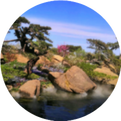Yang Qi disorders can be categorized into two main types, aside from excessive Yang: one is Yang stagnation and the other is Yang deficiency. Yang stagnation occurs when Yang Qi is obstructed due to Qi stagnation, blood stasis, dampness obstruction, fluid retention, phlegm accumulation, or cold congealing, and the treatment should focus on invigorating Yang. The methods to invigorate Yang should be tailored to the specific symptoms: for Qi stagnation, use Qi-regulating techniques; for blood stasis, use blood-activating methods; for dampness obstruction, use dampness-dispelling techniques; for fluid retention, promote fluid metabolism; for phlegm accumulation, transform phlegm; and for cold congealing, disperse cold. Among those with cold-congealed Yang stagnation, there are two treatment approaches: one is to warm Yang and disperse cold, using Fu Gui Jiang (Cinnamon and Ginger) as an example (note that Fu Gui Jiang alone does not tonify Yang, but rather warms it); the other is to promote urination, as emphasized by Ye Gui (Cinnamon Leaf) stating that “invigorating Yang is not about warming but about promoting urination” (of course, for those with Yang stagnation due to dampness obstruction or fluid retention, promoting urination is also a primary treatment).
Yang deficiency refers to insufficient Yang Qi, and the treatment should focus on tonifying Yang. The herbs used to tonify Yang are not limited to Fu Gui Jiang alone; they must be combined with Yin-nourishing and warming herbs or those that are rich in blood and essence, such as Shu Di (Rehmannia), Shan Zhu Yu (Cornus), Shan Yao (Dioscorea), Xian Ling Pi (Polygonatum), Rou Cong Rong (Cistanche), Tu Si Zi (Cuscuta), Zhi Shou Wu (Polygonum), Lu Jiao (Deer Antler), Lu Rong (Deer Velvet), Zi He Che (Placenta), and Yang Rou (Lamb) are all suitable for this treatment. Additionally, when tonifying Yang, it is essential to use specific herbs targeting the corresponding organs, such as using dried ginger to tonify Lung Yang, cinnamon twig for Heart Yang, dried ginger or Fu Long Gan for Spleen Yang, cinnamon for Kidney Yang, and Shan Zhu Yu for Liver Yang. Furthermore, if the methods of invigorating Yang can be incorporated into the foundation of tonifying Yang, the effects of tonifying Yang will be even better. In summary, invigorating Yang, warming Yang, and tonifying Yang are distinctly different, especially the methods of warming and tonifying should not be confused.

